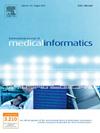A comparative analysis of trauma-related mortality in South Korea using classification models
IF 3.7
2区 医学
Q2 COMPUTER SCIENCE, INFORMATION SYSTEMS
International Journal of Medical Informatics
Pub Date : 2025-02-01
DOI:10.1016/j.ijmedinf.2025.105805
引用次数: 0
Abstract
Background
Reducing mortality among severe trauma patients requires the establishment of an effective emergency transportation system and the rapid transfer of patients to appropriate medical facilities. Machine learning offers significant potential to enhance the efficiency and quality of these emergency medical services.
Methods
A retrospective secondary analysis was conducted using region-specific trauma survey data. The analysis focused on socio-economic characteristics, mechanisms of injury, injury severity, and variables indicating the effectiveness of the emergency medical system in optimizing machine learning algorithms for predicting severe patient transportation decisions.
Results
Among the 8,769 patients with severe trauma, 7.2 % died in the hospital, with an average age of 50.06 years. The average injury severity score was 8.44, and the average time from accident reporting to arrival at the emergency medical facility was 55.39 min. The trend showed that as the level of the emergency medical institution increased, the patient transport time increased, while the mortality rate decreased. Additionally, XGBoost showed the best performance in mortality classification using a dataset sampled with SMOTE-ENN. Although the difference was minimal, undersampling slightly outperformed oversampling in the classification of emergency patients.
Conclusion
The treatment of emergency patients is influenced not only by transport time but also by the resources and staff levels of specialized emergency medical centers, which in turn affect survival rates. Furthermore, given the superior performance of composite sampling methods in analyzing imbalanced datasets, the importance of considering such imbalanced datasets in the analysis is evident.
使用分类模型对韩国创伤相关死亡率进行比较分析
背景:降低严重创伤患者的死亡率需要建立有效的紧急运输系统,并迅速将患者转移到适当的医疗设施。机器学习为提高这些紧急医疗服务的效率和质量提供了巨大的潜力。方法采用区域创伤调查资料进行回顾性二次分析。分析的重点是社会经济特征、损伤机制、损伤严重程度和变量,这些变量表明急诊医疗系统在优化机器学习算法以预测重症患者转运决策方面的有效性。结果8769例重型外伤患者中,7.2%在医院死亡,平均年龄50.06岁。伤情严重程度平均评分为8.44分,从事故报告到到达急救医疗机构的平均时间为55.39 min。趋势表明,随着急救医疗机构水平的提高,患者转运时间增加,死亡率下降。此外,使用SMOTE-ENN采样的数据集,XGBoost在死亡率分类方面表现出最佳性能。虽然差异很小,但在急诊患者的分类中,欠采样略优于过采样。结论急诊患者的救治不仅受转运时间的影响,还受专科急诊医疗中心资源和人员水平的影响,进而影响生存率。此外,考虑到复合采样方法在分析不平衡数据集方面的优越性能,在分析中考虑这些不平衡数据集的重要性是显而易见的。
本文章由计算机程序翻译,如有差异,请以英文原文为准。
求助全文
约1分钟内获得全文
求助全文
来源期刊

International Journal of Medical Informatics
医学-计算机:信息系统
CiteScore
8.90
自引率
4.10%
发文量
217
审稿时长
42 days
期刊介绍:
International Journal of Medical Informatics provides an international medium for dissemination of original results and interpretative reviews concerning the field of medical informatics. The Journal emphasizes the evaluation of systems in healthcare settings.
The scope of journal covers:
Information systems, including national or international registration systems, hospital information systems, departmental and/or physician''s office systems, document handling systems, electronic medical record systems, standardization, systems integration etc.;
Computer-aided medical decision support systems using heuristic, algorithmic and/or statistical methods as exemplified in decision theory, protocol development, artificial intelligence, etc.
Educational computer based programs pertaining to medical informatics or medicine in general;
Organizational, economic, social, clinical impact, ethical and cost-benefit aspects of IT applications in health care.
 求助内容:
求助内容: 应助结果提醒方式:
应助结果提醒方式:


